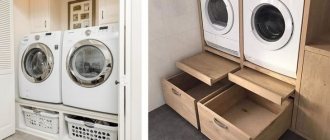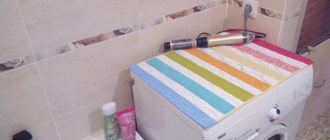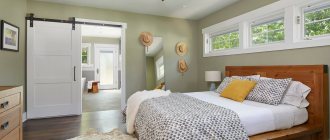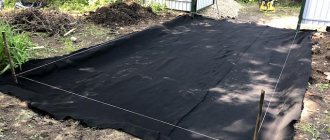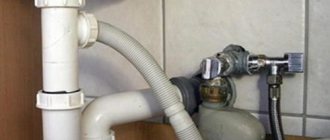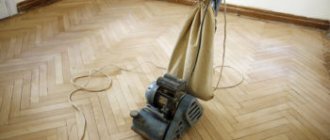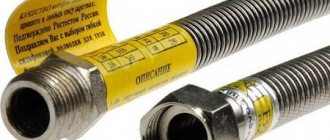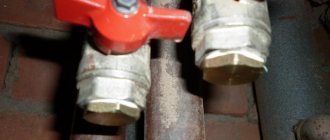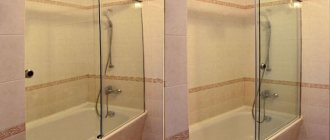Tee in the bathroom between the machine mixer. The position of the electrical outlet is also a point that should be taken into account: it is better if it is placed next to the machine. If it is not there, you should consider installing it. The use of an extension cord is not advisable due to the dangerous proximity of water.
Socket next to the washing machine.
Advantages and disadvantages
When considering the issue of installing a washing machine in the dressing room, people are faced with doubts and prejudices, the pros and cons of the idea. It is worth highlighting the main advantages of this solution:
- Such a design will free up extra space in the bathroom or kitchen.
- Installing the device in a storage room saves time, because you can sort through, store and rinse clothes in one room. Here the washed items are hung on hangers and dried.
- The washing machine can be installed in a special cabinet with a spacious lower compartment. This will complement the design of the dressing room and save space.
Despite significant advantages, this layout option has its disadvantages:
- During installation of the machine, owners may encounter technical difficulties. This includes the availability of outlets, ventilation and suitable space.
- A large washing machine in a dressing room can damage the floor covering, so it is better to install it on concrete tiles.
- If the dressing room is located at a large distance from the sewer pipe, there may be a problem with pumping out soapy and dirty water.
Installing a washing machine in a storage room is an original and profitable idea. However, before implementing it, it is worth weighing all the pros and cons in order to avoid unpleasant consequences.
Activator washing machine
These are the simplest and cheapest devices. Most of the actions, such as heating and supplying water, draining it, rinsing, spinning, are performed manually. Structurally, the activator machine is a plastic or metal container, inside of which (at the bottom or on the side) there is a rotating disk with blades; it moves the laundry, washing it. There is a hole at the bottom for draining dirty water; it is discharged through a drain hose.
Devices of this type are produced by both domestic and foreign manufacturers. There are many models on sale, it is easy to choose the best option, guided by the required power and price.
The main advantages of machines of this type:
- lowest price among other options,
- portability, most models are made of plastic, they are easy to carry, can be installed on any more or less flat area,
- ease of use, the only thing that is regulated in this machine is the washing time,
- does not require sewerage, water is drained via a drain hose.
Among domestic models, the most popular are the “Malyutka” series cars. They are distinguished by a low price with quite acceptable characteristics.
Washing machine "Fairy"
A fairly popular domestic model, it was produced by Soviet industry. It has a strict design and low (about 160 W) power consumption. With a permissible load of 3 kg of laundry and a low dead weight, this is one of the best options for a summer residence.
"Assol" HRV 50-880S
Another model ideal for use in the country. The machine can wash up to 5 kg of laundry in one go, and both standard washing and delicate mode are possible. The machine allows you to wash followed by rinsing (replacing the water manually), in addition, there is a “wash only” mode, which allows you to reuse water.
"Princess"
An almost ideal mini washing machine for the dacha, fully justifying the term “portable”. It allows loading only 1 kg of laundry, but it is extremely small in size, which allows you to take it with you to the dacha and then take it back.
Design Features
Before installing the equipment, you need to inspect the selected room and determine the most advantageous place for washing. Owners should consider the following points in such cases:
- You shouldn’t immediately gouge the walls to identify a new outlet. Initially, it is worth assessing the chosen location for compliance with the protruding elements, height and width.
- In addition to the main size of the device, it is worth retreating about 10 cm, since hoses will be located on the back side of it.
- When a place has been allocated, you will need to check the strength of the floor. If the apartment is old and the flooring leaves much to be desired, it is better to fill the allocated space with concrete or lay tiles on it. Wooden pop can cause the body to collapse. The floor structure must support up to 90 kg of weight.
- If the floor in the apartment is uneven, then there is no need to worry. You can adjust the stability of the equipment using a building level.
- It is also worth choosing a place that is located near a sewer pipe. If it is located at a distance of more than 3 meters from the washing machine, dirty water will be difficult to drain, which will lead to subsequent breakdowns.
- Before installation, you need to inspect the hose from the washing machine. Usually it has a length of up to 1.5 m. If this size is not enough, it is worth changing the hose to a longer one.
Once all the parts are prepared, you can begin the installation process.
How to position
When installing a refrigerator in the hallway, consider the following:
- While working, it gives off heat. Therefore, you cannot place it closer to the wall than 10 cm;
- Do not allow the case to overheat. It should be located away from heating radiators, ovens and stoves - at a distance of at least 50 cm. It should be protected from direct sunlight;
- It is advisable to connect equipment directly, without extension cords or adapters. Therefore, the outlet must be nearby;
- The equipment should be installed on a flat surface. This will help avoid noise during its operation;
- Convenient hanging of refrigerator doors and the ability to open them unhindered is another factor that affects ergonomics.
If you decide to place the refrigerator in the hallway, you can choose one of the options:
- Hide it in the closet;
- Embed;
- Just put it against the wall.
In the closet
If the size of the room allows, you can put a cabinet with a refrigerator inside. This option helps maintain a unified hallway style. This solution turns the unit into invisible, and simple furniture turns out to be a box with a secret.
Refrigerator hidden in the closet.
Miniature models can be conveniently placed in a wide cabinet, which can belong to any style direction - from classic to loft.
Refrigerator in the loft style hallway.
Built-in
You can hide equipment in different ways.
- There are special models that require installation in a cabinet. Their outer side has a special fastening system where the facade is installed. This is how the equipment is integrated into the existing furniture ensemble;
- A refrigerator in a niche will help you make the most of the hallway space. The niche can be closed with sliding doors, organizing a wardrobe. A tall “barn” door on wheels will give the interior a rustic feel;
- If the hallway has a storage room of a suitable size, you can place the equipment there.
Near the wall
Often the size of the room does not allow you to hide the refrigerator. Then it is placed against the wall. Do not forget that the distance to the wall must be at least 10 cm. The handles must not interfere with movement. It is necessary to achieve maximum comfort when opening doors: nothing should limit them.
Installation of equipment
Before starting the process, you should prepare for the fact that owners will face additional material costs. Their level depends on the characteristics of the room and equipment. What does the preparatory process look like:
- The first step is to provide the necessary ventilation for the dressing room. Constant washing causes dampness, which leads to the formation of fungus and mold. Constant air circulation will solve problems and eliminate unnecessary inconvenience. Many residents skip this point and hope for a constantly open door. However, this brings constant inconvenience and leads to air pressure.
- Now you need to think about connecting the equipment to the water supply and sewer pipes. Previously, the procedure was carried out using special taps and rubber hoses. Today, such techniques are already outdated. Because the drain and inlet hoses are already installed in the equipment.
- When installing adapters, it is better to rely on the shut-off valve. It allows you to shut off the water after the end of the cycle and during repair work.
- Now you need to cut a special recess to install the tee. Tools for work are selected depending on the material of the main pipe.
- Next, connect the equipment to the sewer. Here residents may encounter difficulties, so if they do not have the proper experience, it is better to contact an experienced master.
- Now comes the turn of the sockets. They are rarely found in the dressing room. Therefore, they must be done near the washing machine. If there is an old outlet in the room, it is better to replace it. Sufficient power is required for stable operation of the equipment. Old sockets will not be able to provide this. This will lead to equipment failure or fire. It is worth noting that connecting equipment to the network using extension cords is prohibited. It is best to provide direct access to the network.
- To install the socket, you should focus on parts with a moisture-resistant housing; they are characterized by a long service life and reliability.
- They make a place for the electrical network at the same level as the washing machine. Before starting the process, you will need to turn off the power supply to the apartment.
- Now you can make the markup. The optimal distance is up to 100 cm from the floor. You need to mark the measurements using a simple pencil.
- Next, you need to determine what size wiring is needed to lay the path from the equipment to the junction box. It is better to measure out the extra 30 cm in case of repairs or changes in design.
- Select a drill attachment suitable for a specific wall and drill holes. If you don’t have a variety of attachments at home, it is recommended to use the standard one. All actions are performed using a respirator and gloves.
- Next, based on the markings provided, you need to drill a small hole for the future outlet.
- Using a grinder, make a 4 cm groove.
- Thoroughly clean the resulting holes from dust and dirt, fix the socket box in the hole made.
- Place the wire under it. One end of it will need to be connected to the shield, and the other to a drilled hole in the wall.
- To make the structure invisible, it is masked using plaster or putty. It is imperative to wait until the mixture hardens.
- Now you can insert the socket itself and connect the wires.
When connecting wires, it is better to use terminals that will help make the procedure safe. When testing the outlet, you should listen to the smell. If there is no haze or burning, then everything was done correctly.
Connection to water supply
If you can connect the drain from the equipment either directly to the sewer or using a siphon, then there are several options for connecting water:
Crimp coupling for connecting metal pipes. A hole for connection is created in the pipe, a coupling is placed on the pipe, and a ball valve with a 3/4 threaded outlet is placed on it. An inlet hose is connected to the outlet.
Crimp coupling for connection to metal-plastic pipes. After cutting into the pipe, the fitting is connected. The connections are sealed. A tap is connected to the fitting, and a filling pipe is connected to it.
Tee when connected through a sink faucet. At the junction of the water supply lines and the mixer hose, a tee is screwed in, to which the pipe from the machine is connected.
Tee if there is a water outlet in the wall. The equipment is connected to it directly through a tap.
Ensuring stable ventilation
After installing the socket and connecting the machine to the sewer, you can safely wash your clothes. However, if the dressing room is not large in size and does not have windows, you should think about normal ventilation in the room. Otherwise, mold and a damp smell will appear in it, which will appear on hanging clothes. To organize ventilation, the following measures are taken:
- Make a small hole between the floors and a door.
- Install a special door containing bars.
- Make holes in the walls, which are kept at a distance of up to 30 cm from the floor covering. According to user reviews, this is one of the most reliable options.
- Make a hole in the floor. A similar method is used in private houses with a basement floor.
Normally, the dressing room should be regularly ventilated and there should be good air circulation. The integrity of the clothes, their smell and the degree of contamination depend on this. It would be a good idea to organize an exhaust duct. It is made using a special grille, which is installed right under the ceiling.
If the dressing room is large, it is better to make several similar channels, which will be located at a decent distance from each other.
Automatic washing machines for cottages
Times are changing, civilization is gradually coming even to the most remote corners of the country. Many holiday villages are already connected to the main water supply; some craftsmen are building an autonomous water supply at home. The presence of running water in the system with sufficient pressure allows you not to limit yourself and install a full-fledged automatic machine in your dacha.
Using an automatic washing machine:
- will allow fully automated washing,
- will save time, because the machine does everything itself, it does not need supervision,
- will allow you to rationally use water and electricity.
When choosing a machine for your dacha, you should be guided primarily by your preferences. Perhaps the only thing that should be taken into account when choosing a washing machine for your dacha is its size, although it all depends on the size of the dacha itself.
ZANUSSI ZWY61005RA
This device is not compact, but it is quite convenient to use, has low energy consumption, and allows you to use water efficiently. This is a top-loading machine, the maximum weight of laundry is 6 kg.
ELECTROLUX EWT0862IDW
The device is of the same class as the previous model. A good choice for a cottage or apartment. The manufacturer has proven itself exceptionally well, which is a guarantee of long service life of the washing machine.
Installing a machine mount
During washing, the equipment produces strong vibrations and shocks, which put strong pressure on the floor. Because of this, it is not recommended to install the device on wooden or weak floors. To get out of this situation, you can use the following constructions:
- Using a special mat with an anti-vibration function. It helps reduce the percentage of pressure on the floor and protect the washing machine from damage.
- Installation of a massive concrete slab. Such a design will take time, however, it can reduce the level of vibrations during washing. It is worth remembering that concrete coating will not correct problems with the floor and will not make it smoother.
- Construction of an installation elevated above the floor. To do this, you will need to cut 4 holes in the floor, insert metal pipes into them and cover them with a durable plywood sheet. This design reduces the amount of vibration, but quickly becomes unsuitable for use.
When all the details are prepared, you can safely use the washing machine installed in the dressing room.
Washing machines for cottages without running water
A huge number of holiday villages still do not know what water supply and sewerage are. The realities of modern times, but in any case you can’t do without washing; you need to wash regularly, in families with children several times a day.
There are many modifications of washing machines suitable for cottages without running water. Most popular:
- simple devices with an activator,
- semi-automatic devices,
- full automatic machines with water tank.
The choice of one model or another depends on many factors. It is important to consider the average wash volume, the availability of water sources and, of course, the amount that can be spent on the purchase.
Some tips for making a cabinet
If you are planning to hide SMA in a closet (or cabinet), you can use various building materials to make them:
- using MDF panels you can easily make a cabinet that will easily fit into any interior with its shapes and colors;
- a good solution is natural wood material. Such furniture will fill the hallway with comfort, but before installing washing equipment, its internal parts will have to be additionally treated with a water-repellent composition;
- steel and glass in combination will add modernity and technology to the corridor. To make the door leaf, transparent or frosted tempered glass is used;
- panels for making furniture are a durable and beautiful natural material, furniture from which has a long service life. To make such shields, wood is used, previously cut into strips, which are then glued together.
The cabinet can be made in a floor-standing or built-in form; a wall-mounted design would also be a good solution. Furniture shapes for installing a washing machine can be straight or angular.
Cabinet doors should be installed taking into account the actual capabilities of the corridor and the loading option for washing equipment. They are available in swing, sliding or folding versions. It is allowed to use vertical blinds as shutters.
